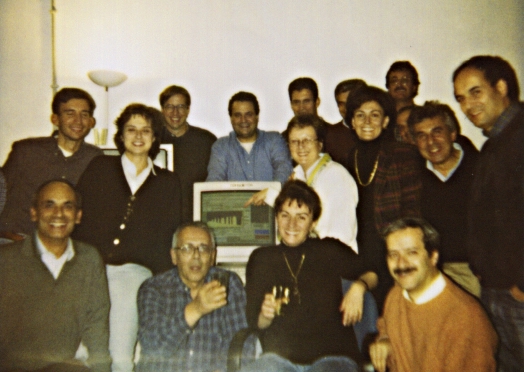
The DAFNE team celebrating first multibunch operation
1030 cm-2s-1 SINGLE BUNCH LUMINOSITY ACHIEVED
Click here to check the Commissioning Status
1 AMP BEAM CURRENT STORED IN POSITRON RING
On Monday, May 29, 2000, more than 1 A beam current has been stored for the first time in the positron ring. The current was distributed between 60 equally spaced bunches. No significant instabilities were observed during stacking.
FIRST BEAM-BEAM INTERACTIONS IN KLOE
On Wednesday, April 14, 1999, during the first tune-up of DAFNE with two beams and the superconducting detector solenoid in operation, a luminosity of 1.2*1029 cm-2s-1 has been reached in single bunch mode with 11 mA in the positron beam and 7 mA in the electron one, corresponding to ~70% of the luminosity expected for this current.The first Bhabha scattering events have been observed in the KLOE detector. A preliminary estimate of the event rate is in agreement with the indications of the machine luminosity monitor.
COMPENSATION OF KLOE SOLENOID ACHIEVED
After less than one week of machine commissioning with the superconducting KLOE detector solenoid and compensators on, compensation of coupling has been reached for both electron and positron beams with the same configuration of the interaction region. The measured residual coupling is less than 3% for both beams.
FIRST BEAM STORED IN DAFNE WITH KLOE ON
On Sunday, March 28, 1999 the positron beam was stored in DAFNE with the superconducting KLOE detector solenoid and compensators running at their nominal field.
FIRST MULTIBUNCH LUMINOSITY AT DAFNE
During two weeks of DAFNE commissioning, still in progress, just before the KLOE detector installation, two beam multibunch operation has been realized for the first time on Friday, November 13. 13 bunches have been stored in each beam up to a maximum current of 200 mA each. Luminosity in the range of 1031 cm-2 sec-1 in multibunch configuration (13 bunches/beam) has been measured.

The DAFNE team celebrating first multibunch operation
1030 cm-2s-1 SINGLE BUNCH LUMINOSITY ACHIEVED
On Saturday, October 31, 1998, during a two weeks shift dedicated to single bunch luminosity tune-up, the commissioning milestone of 1030 cm-2s-1 has been several times exceeded in the DAFNE Main Rings.
FIRST COLLISIONS IN DAFNE
On Sunday, March 1, 1998 the first electron-positron collisions have been achieved in the DAFNE Main Rings.
The collider was running in the single bunch mode, with the current in each beam ranging from 1 to 4 mA.
The maximum value of the luminosity was between 2 and 3 x 1028 cm-2 s-1. This value must be scaled by a factor of ~100 at the design current of 40 mA per bunch.
NOMINAL POSITRON CURRENT IN SINGLE BUNCH MODE EXCEEDED on NOVEMBER 28, 1997
During the scheduled first 2 weeks of commissioning, on November 28, 1997, the single bunch design current (44 mA) has been exceeded in the positron ring of DAFNE. After optimizing the transport efficiency from the Accumulator to the Main Ring, and correcting the chromaticity by means of the sextupoles in the achromats, ~70 mA in a single bunch have been easily stored.
Multibunch injection has also been successfully tested, reaching 250 mA limited by residual gas pressure in the vacuum chamber. No evidence of any instability has been so far detected.
FIRST POSITRON BEAM STORED INTO THE DAFNE MAIN RING on NOVEMBER 22, 1997
After storing the first positron beam into the Accumulator on November 19, the following two days have been spent in optimizing the injection rate. Having reached more than 10 mA/s into the Accumulator, the commissioning of the Transfer Line from the Accumulator to the positron Main Ring was started.
On Saturday, November 22 after lunch, the beam was driven on the fluorescent screen after the injection septum magnets. After half an hour, spent in tuning all the magnets, the first 0.5 mA positron bunch was stored at 16.30 p.m. The measured lifetime at zero current was of the order of one hour. Further commissioning is under way.
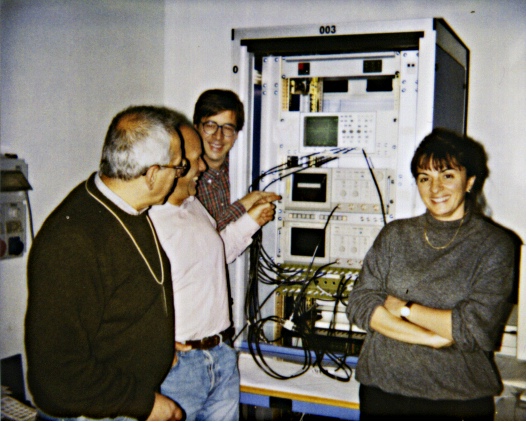
The DAFNE Project Leader Gaetano Vignola and some young collaborators in the Control Room showing proudly the oscilloscope trace of the first positron beam stored into the DAFNE Main Ring
The injection rate has been then improved and the stored current reached 35 mA. Extraction of the stored beam has also been successfully performed. Further commissioning is under way.
FIRST ELECTRON BEAM STORED INTO THE DAFNE MAIN RING on OCTOBER 25, 1997
The first electron beam has been stored into the electron ring of the DAFNE collider on October 25, 1997 at 10.30 p.m. During a shift started at 2 p.m. the 510 MeV electron beam has been transported to the injection point of the electron Main Ring. With the RF cavity off it was possible to keep the beam inside the ring for ~0.3 ms, which is the maximum value allowed by the energy loss due to the emission of synchrotron radiation and the aperture of the vacuum chamber.
The RF cavity was then switched on and the beam captured and stored in the ring. The position of the beam along the ring has been measured by means of the beam position monitors and found to be in agreement with the alignment tolerance. Multistacking was also successfully performed.
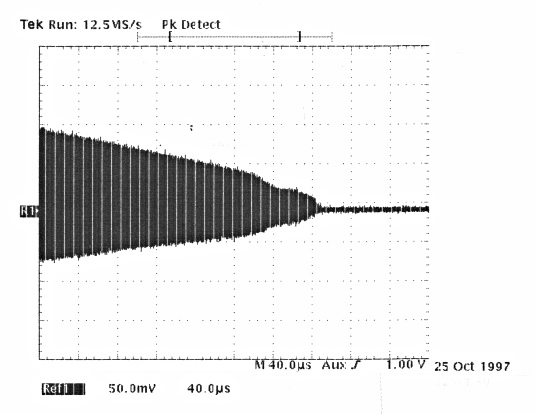
Beam current waveform in DAFNE with the RF cavity off. The decrease is due to the drift of the particles towards the inside of the ring induced by the emission of synchrotron radiation and the vacuum chamber aperture limit. The beam survives inside the vacuum chamber for ~0.3 ms.
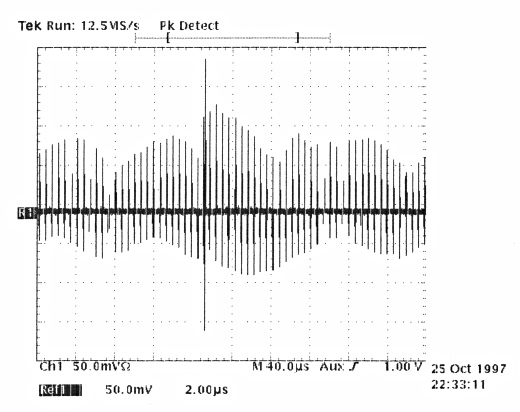
Signal of the first electron beam stored into the DAFNE Main Ring. The oscilloscope was triggered on the injection pulse (the highest spike near the center of the screen). Since the injection rate was 0.5 Hz, the spikes on the left are due to beam survived for 2 seconds inside the ring. The distance between successive spikes corresponds to the revolution time (320 ns)
FIRST ELECTRON BEAM INJECTED INTO THE DAFNE MAIN RING on SEPTEMBER 28, 1997
On Sunday, September 28, at 10,40 p.m. the first electron beam has been injected into the electron ring of the DAFNE collider. During a 10 days shift started on September 18, the electron beam has been extracted for the first time from the Accumulator. After reaching 100% efficiency extraction and stable operation in the damping ring, the beam has been driven through the Transfer Line up to the pulsed magnets which allow the passage of the beam in both directions through the same vacuum vessel. Commissioning of these special magnets has been completed rapidly and successfully. The beam has been then transported along the ~70 m long channel up to a fluorescent screen target right at the entrance of the electron ring.
After extracting the target, the beam has been detected by means of beam position monitors along the first quadrant of the Main Ring.
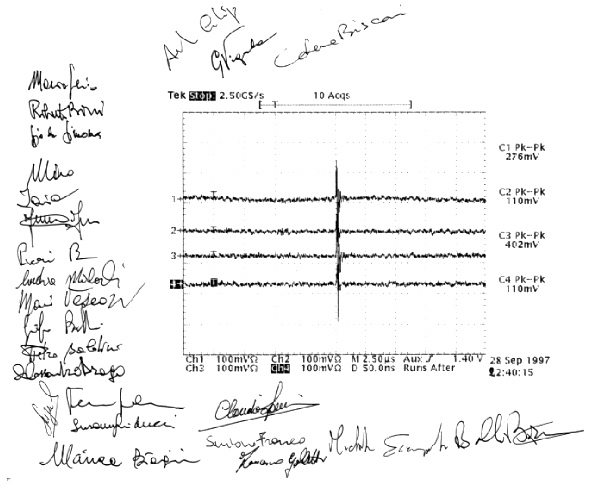
Beam signal on a"button" beam position monitor inside the DAFNE electron ring (from the DAFNE logbook)
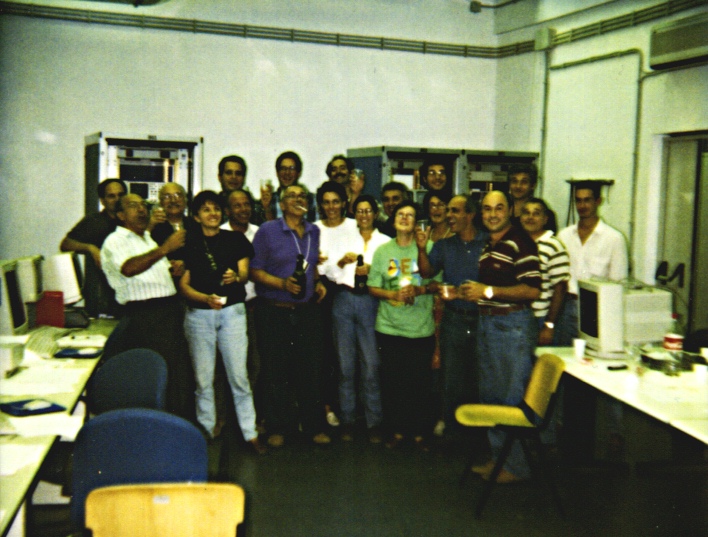
The DAFNE staff on shift during the first injection into the Main Rings celebrating the event.
MAIN RINGS COMPLETELY ASSEMBLED AND UNDER VACUUM on AUGUST 7, 1997
The vacuum-mechanical assembly of the DAFNE Main Rings was successfully concluded on August 6, 1997, with the installation of the last section of vacuum chamber in the FI.NU.DA Interaction Region. The vacuum system, already in operation on the achromats, was switched on also in the last segments, and the day after, August 7, the collider was completely under vacuum.
After tuning only one out of the eight orbit correctors in the ring, some hundreds revolutions in the ring were observed (without the R.F. field in the cavity) on the strip-line position monitors of the Accumulator.
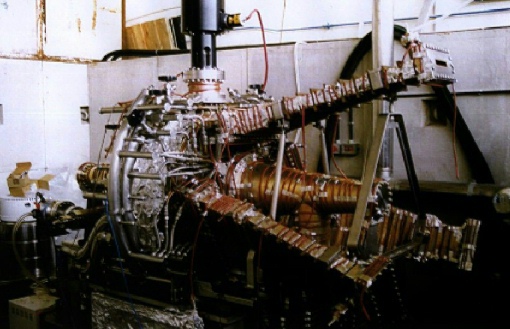
The first RF cavity for the DAFNE Main Rings, fully equipped with 3 HOM waveguide absorbers, has been power tested in a dedicated RF Hall. In one day of RF conditioning the input power was raised up to 22 kW/cw for a gap voltage of 300 kV-peak, which is more than required for the DAFNE operation. The measured quality factor of the cavity is 33000. No multipactoring or discharges occurred during the tests.